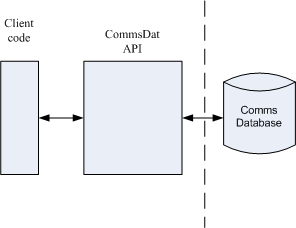Concepts
This section describes the ideas that underly the Comms Database.
The Comms Database provides system wide storage for communications related settings. The Comms Database holds information about Internet Access Providers (IAPs), Internet Service Providers (ISPs), GPRS, modems, locations, charge-cards, proxies, WAP settings etc. The Comms Database holds this information as a set of related tables.
Symbian platform defines the format of this information, but the Comms Database can also contain user-defined data. Symbian support for user-defined data is limited to backup and security.
Tools and applications that manage voice and data transmissions use the Comms Database.
The Comms Database is a persistent store. Tools and applications use the CommsDat API to access the data in the Comms Database. The CommsDat API hides the structure of the data on the database. The CommsDat API also hides the implementation of the database, and allows the implementation to change in future versions of Symbian platform without a change to client code.
The current version of Symbian platform implements the Comms Database in the Central Repository.
The Comms Database is available on all Symbian platforms.
- What is the CommsDat API
This topic is an intrdouction to the CommsDat API. Tools and applications use the CommsDat API to access the data in the Comms Database. - What are elements
This topic describes elements. All items that can be stored in the Comms Database are elements. The topic also discusses the structure of the unique numeric Id and the attributes that control access to elements. - What are containers
This topic describes the abstract idea of a containers. A container is the general term for a field, a record, a link and a table. - What are fields
This topic describes the structure of a field. A field is an item that can be stored in the Comms Database. - What are records
This topic describes the structure of record. A record is an item that can be stored in the Comms Database. - What are links
This topic describes the structure of links. A link is a container and an element. A link is an item that can be stored in the Comms Database. - What are tables
This topic describes the structure of a table. A table is an item that can be stored in the Comms Database. - What is Versioning?
This topic describes the purpose and uses of versioning. - What are sessions with the Comms Database
This topic describes the use of sessions to access the Comms Database. - What are transactions
This topic describes the purpose of transactions when accessing the Comms Database. - What is the mechanism for reading, writing and searching for data
This topic describes the mechanism for reading data from the Comms Database and writing data to the Comms Database. - Notification of changes to the comms database
This topic describes the mechanism that allows the CommsDat API to notify tools and applications of changes to the Comms Database. - How is the Comms Database secured
This topic describes the security issues that govern access to the Comms Database.
